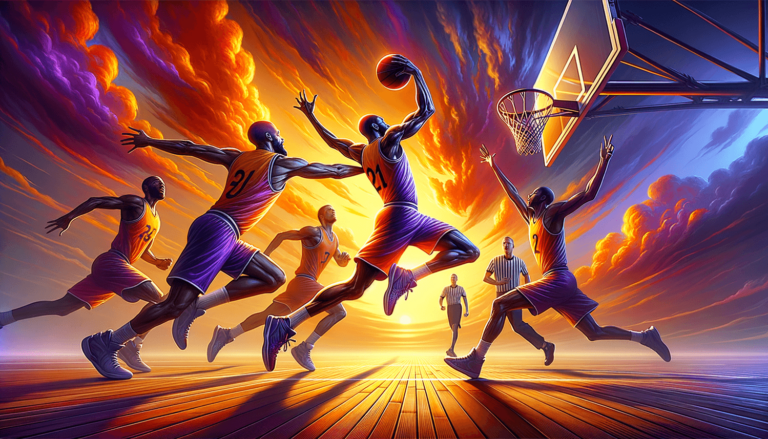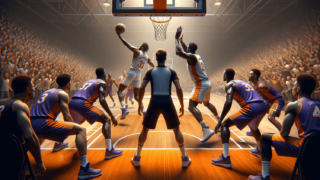
Swishing through nets and thundering slam dunks may dominate the highlight reels, but those tense moments when a referee blows the whistle and calls for a foul are just as essential to the energy and strategy of a basketball game. So, what exactly is a foul in basketball? In this engaging and comprehensive blog post, we’ll delve into the intricate world of fouls, from types and significance to their role in shaping the beautiful game we know and love. Get ready to master the art of basketball fouls and elevate your understanding of the sport to exciting new heights!
What Is a Foul in Basketball?
A foul in basketball refers to a violation of the rules, typically involving illegal physical contact between players. Fouls can be categorized as personal, technical, flagrant, or unsportsmanlike. When a player commits a foul, the opposing team may be awarded free throws or possession of the ball, depending on the nature and severity of the infraction.
Understanding the Different Types of Fouls
There are various types of fouls in basketball, each carrying distinct implications and consequences for the players and teams involved. In this section, we’ll explore the different kinds of fouls to help you distinguish between them and better appreciate the nuances of the game.
Personal Fouls
Personal fouls are the most common type of infraction in basketball. They involve illegal physical contact between players, usually hindering an offensive player’s progress or placing a defensive player at a disadvantage. Examples of personal fouls include holding, blocking, charging, tripping, and pushing. When a personal foul is committed by the defensive team, the offensive team may be awarded free throws, depending on the game situation and the specific foul committed. Conversely, an offensive team committing a personal foul will usually lose possession of the ball.
Technical Fouls
Technical fouls are non-contact violations committed by players, coaches, or other team personnel. These infractions usually involve unsportsmanlike conduct, such as arguing with referees, using inappropriate language, engaging in excessive trash talk, or deliberately stalling the game. Players and coaches can also receive technical fouls for illegal defensive formations or incorrect substitution procedures. When a technical foul is called, the opposing team is awarded one free throw, and play resumes from the point where the foul occurred. A player or coach who accumulates two technical fouls in a game is automatically ejected.
Flagrant Fouls
Flagrant fouls are severe personal fouls committed with excessive force or intensity, often resulting in injury or potential injury. This category of fouls is divided into two levels: Flagrant Foul 1 and Flagrant Foul 2. A Flagrant Foul 1 is considered unnecessary contact, while a Flagrant Foul 2 involves contact that is deemed both unnecessary and excessive. The key difference between these two types of fouls lies in the severity of the infraction and the intent of the player. The penalty for a Flagrant Foul 1 is two free throws and possession of the ball for the opposing team, while a Flagrant Foul 2 results in the same penalty plus the automatic ejection of the player who committed the foul.
Unsportsmanlike Fouls
Unsportsmanlike fouls, also known as intentional fouls, involve deliberate physical contact with an opposing player with no legitimate attempt to play the ball. These fouls may be committed to slow down the pace of the game, to stop the clock, or to disrupt an advantageous offensive play. Unsportsmanlike fouls typically carry a penalty of two free throws and possession of the ball for the opposing team.
How Foul Calls Impact the Game
Foul calls can significantly impact the flow, strategy, and outcome of a basketball game. In this section, we will examine the ways in which fouls change the dynamics of the game and influence teams’ tactical approaches.
Free Throws and Possession
When a defensive player commits a personal, flagrant or unsportsmanlike foul, the offensive team may be awarded free throws. Free throws provide the fouled team with an opportunity to score points without facing the defense. The number of free throws awarded depends on the specific foul committed and the game situation. Additionally, some fouls also result in possession of the ball, which offers the fouled team another chance to attack the basket.
Foul Trouble and Player Substitution
Players are limited in the number of personal fouls they can commit during a game. In most leagues, a player is disqualified from the game upon picking up their fifth or sixth foul, depending on the league’s rules. Coaches must closely monitor their players’ fouls and carefully strategize substitutions to ensure that vital players are not forced to leave the game prematurely due to foul trouble. This aspect of basketball management can often make the difference between victory and defeat in closely fought contests.
Impact on Playing Style and Tactics
Foul calls influence the way players approach the game, both offensively and defensively. Players must balance their aggressiveness with discipline to avoid accumulating fouls and putting their team at a disadvantage. Coaches may also adjust their strategies based on the foul situation, instructing their teams to target specific opponents in foul trouble or exploit weaknesses in the opposition’s defense.
How Foul Calls Are Made and Reviewed
The process of calling, reviewing, and enforcing fouls in basketball is essential to maintaining fair play and ensuring that games unfold according to the established rules. In this section, we’ll explain the role referees play in identifying, calling, and evaluating fouls on the court.
Referees’ Responsibility and Judgment
In a basketball game, a crew of referees is responsible for identifying and calling fouls. They assess the players’ actions in real-time, using their knowledge of the rules, experience, and intuition to determine whether an infraction has occurred. Referees must make split-second decisions and employ their discretion to distinguish between legal and illegal contact, often in the heat of the action. Their judgment and success in enforcing the rules are vital to the credibility and competitive balance of the sport.
Reviewing Fouls and Instant Replay
In some leagues and competitions, referees have the option to review specific foul calls or incidents using instant replay technology. This process provides them with the opportunity to analyze controversial plays in slow motion from various angles, ensuring accuracy and fairness in their decisions. The use of instant replay is generally reserved for critical or high-stakes situations, such as potential flagrant fouls, last-second shots, or contested out-of-bounds calls.
Learning the Art of Drawing Fouls
An important aspect of basketball that is often overlooked is the skill of drawing fouls. By cleverly initiating contact or exploiting defensive vulnerabilities, offensive players can put their opponents in precarious situations and create scoring opportunities for their team. In this section, we’ll explore the ways in which players can harness their skills to lure opponents into committing fouls and capitalize on the penalties that follow.
Using Body Control and Awareness
To draw fouls successfully, offensive players need to develop exceptional body control and awareness on the court. These skills enable them to maneuver their bodies into positions where defenders are more likely to commit fouls. For example, a player might use a pump fake to prompt a defender to jump in anticipation of a shot, only to lean into the defender as they shoot to initiate contact and draw a foul.
Attacking Specific Matchups
Another technique players use to draw fouls is to attack specific matchups where they hold a significant advantage. Players may exploit an opponent’s lack of speed, strength, or defensive discipline to force them into committing fouls. This strategy not only opens up opportunities for the offensive team but also puts defenders in foul trouble, potentially limiting their minutes and effectiveness on the court.
Playing Aggressively and Decisively
Foul-drawing is often rooted in aggressive and decisive play. Offensive players who attack the basket with conviction and speed are more likely to initiate contact and subsequently draw fouls. Players must be bold in their attacks, forcing defenders to make snap decisions that may lead to mistakes and fouls.
Strategies to Avoid Committing Fouls
In basketball, staying out of foul trouble is crucial for team success. Skilled defenders can avoid fouls while still shutting down offensive players and protecting the basket. In this section, we’ll share some tips and strategies for playing tenacious defense without incurring unnecessary fouls.
Maintaining Proper Defensive Positioning
The cornerstone of effective, foul-free defense is proper positioning. Defenders should stay between their opponent and the basket, maintaining their balance and using their feet to keep up with offensive players. By being in the right place at the right time, defenders can put themselves in a better position to contest shots, block passes, and deter drives without resorting to risky plays and drawing fouls.
Using Hands and Arms Wisely
One common source of fouls involves improper use of the hands and arms in defense. To avoid fouls, defenders should refrain from reaching or swiping excessively, focusing instead on keeping their hands up and active in passing lanes, and contesting shots with verticality. By utilizing their hands and arms more effectively, players can limit their fouls while still disrupting the offense and making life difficult for their opponents.
Developing Anticipation and Discipline
Avoiding fouls requires a great deal of anticipation and discipline from defenders. Players must develop the ability to read opponents’ movements and react accordingly, positioning themselves to contest shots and passes without committing unnecessary fouls. This skill can be honed through practice, experience, and diligent study of opponents’ tendencies, enabling defenders to make smarter decisions and maintain a clean defensive record.
With this comprehensive understanding of fouls in basketball, you are now equipped with the knowledge needed to appreciate the intricacies and strategies behind these critical moments in the game. So the next time you watch or play basketball, pay close attention to the foul calls and subsequent tactical adjustments, as they can make
The Psychology of Players Dealing with Fouls
Mental fortitude and the ability to cope with the pressure of foul situations can be a significant factor in a player’s performance during a basketball game. This section will delve into the psychological aspects of fouls and how players can stay focused and effective despite the challenges that may arise on the court.
Handling Frustration
Being called for fouls or facing opponents who draw fouls with ease can be a source of frustration for players. It’s crucial for athletes to learn how to cope with these challenges without allowing their emotions to affect their decision-making or performance. Techniques such as deep breathing, mental visualization, and positive self-talk can help players stay composed and regain their focus during challenging situations.
Playing with Foul Trouble
When a player finds themselves in foul trouble, it can be challenging to strike the right balance between aggressiveness and caution. It’s essential for players to understand their strengths and limitations and make adjustments to their game without shying away from their responsibilities on the court. Staying focused on the task at hand and relying on the support of teammates can help a player navigate foul trouble and remain effective.
Rules and Regulations Across Different Leagues
As in any sport, the rules and regulations governing fouls can vary across different basketball leagues and levels of competition. Being aware of these variations will help you better understand and appreciate the subtle differences in how the game is played and refereed around the world.
International vs. American Basketball
While the fundamental concept of fouls remains consistent across all basketball organizations, specific rules and interpretations can differ between international basketball (FIBA) and American basketball (NBA, NCAA). For example, international competition allows for a shorter 14-second shot clock reset after an offensive rebound, encouraging teams to be more aggressive and potentially resulting in more fouls. Additionally, the NCAA employs a bonus free throw system that is distinct from NBA and FIBA rules, further highlighting the differences between leagues.
Adaptation to Rule Changes and Evolution
As the game of basketball evolves, so too do its rules and regulations, including those surrounding fouls. Players, coaches, and officials must continuously adapt to these changes, ensuring they stay up-to-date with the latest rule revisions and interpretations. As such, a keen understanding of the game’s history and development is essential for anyone aspiring to thrive in the ever-changing world of basketball.
This added section, along with the previously discussed aspects of fouls, provides a comprehensive guide to understanding basketball fouls in their entirety. Showcasing the psychological implications, variations across different leagues, and the importance of adapting to evolving rules, emphasizes the far-reaching influence of fouls in the game of basketball. With this knowledge, you can truly appreciate and analyze the strategic implications and impact they have on the sport you love.
Frequently Asked Questions (FAQ)
In this FAQ section, we will address some of the most common questions that arise when discussing fouls in basketball. These concise answers cover a broad range of topics related to fouls, adding further clarity and depth to your understanding of the subject.
1. How many fouls does it take to foul out in the NBA, NCAA, and FIBA?
In the NBA, a player fouls out after committing 6 personal fouls. In both the NCAA and FIBA, a player fouls out after committing 5 personal fouls.
2. Do technical fouls count as personal fouls?
No, technical fouls are recorded separately from personal fouls and do not count towards a player’s total personal foul count.
3. Can a player be ejected for personal fouls alone?
Yes, a player who exceeds the allowed number of personal fouls (5 in NCAA and FIBA or 6 in NBA) will be disqualified, or “fouled out,” and must leave the game.
4. What is a “loose ball foul”?
A loose ball foul occurs when a player commits an infraction while neither team has possession of the basketball, such as during a scramble for a rebound or a loose ball.
5. What is a “team foul”?
A team foul is a collective count of personal fouls committed by players on a team. Team fouls are used to determine if a team has reached the penalty situation, requiring opponents to shoot free throws for subsequent personal fouls.
6. How many fouls does a team need to commit to be in the penalty?
In the NBA and FIBA, a team enters the penalty after committing 4 team fouls in a quarter. In NCAA, a team is in the penalty after committing 7 team fouls in a half.
7. How are free throws awarded for fouls?
Free throws are awarded to the fouled player based on the type and severity of the foul and the game situation. Typically, shooting fouls grant the fouled player 2 or 3 free throws, while non-shooting fouls in the penalty yield 1-and-1 or 2 free throw opportunities.
8. What happens when a player gets a double technical foul?
If a player receives two technical fouls during the same game, they are automatically ejected.
9. Can a defensive player draw a charge foul?
Yes, a defensive player can draw a charge foul by establishing a legal guarding position and absorbing contact from an offensive player who initiates the collision.
10. How many fouls can a coach receive before being ejected?
A coach can receive two technical fouls before being ejected from the game.
11. Are there any situations in which a player can be assessed more than one foul at once?
In some rare circumstances, a player may be assessed a personal foul and a technical foul simultaneously, such as during an altercation with another player.
12. What is the purpose of an officials’ review in basketball?
An officials’ review is used to examine specific game situations, such as potential flagrant fouls, last-second shots, and contested out-of-bounds calls, to ensure accuracy and fairness in officiating decisions.
13. How are fouling strategies used in end-game situations?
In end-game situations, teams may intentionally foul opponents to stop the clock or force them to shoot free throws, especially if they are poor free throw shooters, in hopes of regaining possession and erasing a point deficit.
Featured Posts
- No pillar pages found.





